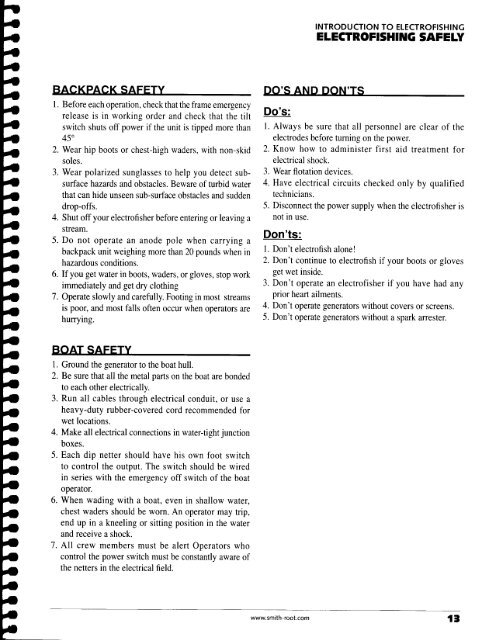Introduction to Electrofishing
Introduction to Electrofishing
Introduction to Electrofishing
Create successful ePaper yourself
Turn your PDF publications into a flip-book with our unique Google optimized e-Paper software.
INTRODUCTION TO ELECTROFISHINGELECTROFISHIIIIG SAFELYBACKPACK SAFETYl. Before each operation, check that the frame emergencyrelease is in working order and check that the tiltDo's:switch shuts off power if the unit is tipped more than l. Always be sure that all personnel are clear of the45"electrodes before turning on the power.2. Wear hip boots or chest-high waders, with non-skid 2. Know how <strong>to</strong> administer first aid treatment forsoles.electrical shock.3. Wear polarized sunglasses <strong>to</strong> help you detect subsurfacehazards and obstacles. Beware of turbid water 4. Have electrical circuits checked only by qualified3. Wear flotation devices.that can hide unseen sub-surface obstacles and sudden technicians.drop-offs.5. Disconnect the power supply when the electrofisher4. Shut off your electrofisher before entering or leaving a not in use.stream.Don'ts:5. Do not operate an anode pole when carrying abackpack unit weighing more than 20 pounds when in l. Don't electrofish alonelhazardous conditions.2. Don't continue <strong>to</strong> electrofish if your boots or gloves6. If you get water in boots, waders, or gloves, s<strong>to</strong>p work get wet inside.immediately and get dry clothing3. Don't operate an electrofisher if you have had any7. Operate slowly and carefully. Footing in most streams prior heart ailments.is poor, and most falls often occur when opera<strong>to</strong>rs are 4. Don't operate genera<strong>to</strong>rs without covers or screens.hunying.5. Don't operate genera<strong>to</strong>rs without a spark arrester.Ground the genera<strong>to</strong>r <strong>to</strong> the boat hull.Be sure that all the metal parts on the boat are bonded<strong>to</strong> each other electrically.3. Run all cables through electrical conduit, or use aheavy-duty rubber-covered cord recommended forwet locations.4. Make all electrical connections in water-tight junctionboxes.5. Each dip netter should have his own foot switch<strong>to</strong> control the output. The switch should be wiredin series with the emergency off switch of the boa<strong>to</strong>pera<strong>to</strong>r.6. When wading with a boat, even in shallow water,chest waders should be worn. An opera<strong>to</strong>r may trip,end up in a kneeling or sitting position in the waterand receive a shock.-All crew members must be alert Opera<strong>to</strong>rs whocontrol the power switch must be constantly aware ofthe netters in the electrical field.www.smith- root.comr3










